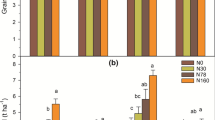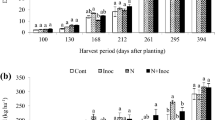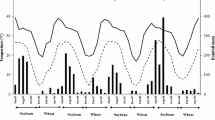Abstract
The N2 fixed by Azolla before and after urea application during the rice cycle, the mineralisation of Azolla-N as well as its availability to rice was studied in two greenhouse experiments conducted in 1996 and 1997 and in June 1998 in Goettingen (Germany). Dry matter production of the various rice parts of experiment 1 showed a clear positive synergism between treatment with Azolla and urea with a resulting apparent N recovery by rice increasing from 40% (without Azolla) to 57% in the presence of Azolla. Part of this increase may be due to N fixed biologically by Azolla and transferred to the rice. The second experiment shed some light on the role of BNF. Using an iterative method of estimation, the daily rate of N fixation was estimated at 0.6 – 0.7 kg N ha−1. The rate was not so much affected by the age of the Azolla crop. At this rate, the BNF would amount to up to 100 kg N ha−1 over a 130-day season. Assuming that BNF may be inhibited for a period of 5 – 10 days following urea application due to high levels of N in the floodwater, this might reduce the BNF by between 6 and 14 kg N ha over the season. Using the mean-pool-abundance concept, it was estimated that around 75 – 80% of the Azolla-N mineralized during the growth period was actually absorbed by the rice plants. Of the N taken up by rice around 28% was derived from the biologically fixed Azolla N, the remainder was urea N cycled through the Azolla. Azolla also seems to help sustain the soil N supply by returning N to the soil in quantities roughly equal to those extracted from the soil by the rice plant.
Similar content being viewed by others
References
Barraclough D 1991 The use of mean pool abundances to interpret 15N tracer experiments. I Theory. Plant Soil 131, 89–96.
Buresh R J and De Datta S K 1991 Nitrogen dynamics and management in rice-legume cropping systems. Adv. Agron. 45, 1–59.
Chalk P M, Smith C J, Hopmans P and Hamilton 1996 A yield independent, 15N isotope dilution method to estimate legume symbiotic dependence without a non-N2-fixing reference plant. Biol Fertil Soils 23, 196–199.
Chalk P M and Smith C J 1997. Estimating nitrogen transfer by foliar 15N labelling in legume – non-legume associations. Biol Fertil Soils 24, 239–242.
Cissé M and Vlek P L G 2003 Conservation of urea-N by immobilization-remobilization in a rice-Azolla intercrop. Plant Soil 250, 95–104.
De Macale M A R, Vlek P L G and San Valentin G O 2002 The role of Azolla cover in improving the nitrogen use efficiency of lowland rice. In The second international conference on sustainable agriculture for food energy and industry. Ed. Li Dajeu. Conference Proceedings Bejing, Vol II, 921–930.
Hamilton S D, Chalk P M, Smith C J and Hopmans P 1992 Evaluation of reference plants by labelling with 35S in the estimation of N2 fixation by 15N isotope dilution. Plant Soil 145, 177–185.
Kumarasinghe K S and Eskew D L 1995 Azolla as a Nitrogen Fertilizer in sustainable rice production. In Nuclear Methods in Soil-Plant Aspects of Sustainable Agriculture. Proceedings of an FAO/IAEA Regional Seminar for Asia and Pacific. Colombo, Sri Lanka, 5–9 Avril 1993, 147–154.
Lumpkin T A and Plucknett D L 1982 Azolla as a green manure: Use and management in crop production. Westview Tropical Agriculture Series, No. 5.
Manna A B and Singh P K 1989a Growth and nitrogen fixation of Azolla pinnata and Azolla caroliniana as affected by urea fertilizer and their influence on rice yield. Plant Soil 122, 207–212.
Manna A B and Singh P K 1989b Rice yields as influenced by Azolla N2 fixation and urea N-fertilization. Plant Soil 114, 63–68.
Mohanty S K, Singh U, Balasubramanian V and Jha K P 1999 Nitrogen placement technologies for productivity, profitability and environmental quality of rainfed lowland rice system. In Resource Management in Rice Systems: Nutrients Eds. V Balasubramanian, J K Ladha and G L Denning. pp 57–77. Kluwer Akademic Publishers, Dordrecht, The Netherlands.
Panda M M, Mosier A R, Mohanty S K, Chakravorti S P, Chalam A B and Reddy M D 1995 Nitrogen utilization by lowland rice as affected by fertilization with urea and green manure. Fertilizer Research 40, 215–223.
Reineking A, Langel R and Schikowski J 1993 15N, 13C-online measurements with an elemental analyser (Carlo-Erba, NA 1500), a modified trapping box and a gas isotope mass spectrometer (Finnigan, Mat 251). Isotopenpraxis Env. Health Stud. 29, 169–174.
Roger P A and Ladha J K 1992 Biological N2 Fixation in wetland rice fields: Estimation and contribution to nitrogen balance. Plant Soil 141, 41–55.
Roger P A 1995 Biological N2-fixation and its management in wetland rice cultivation. Fertilizer Research 42, 261–276.
Singh A L and Singh P K 1987 Comparative study on Azolla and blue-green algae dual culture with rice. Israel J. Bot. 36, 53–61.
Singh A L, Singh P K and Lata P 1988 Effects of different levels of chemical nitrogen (urea) on Azolla and Blue-green algae intercropping with rice. Fertilizer Research 17, 47–59.
Singh Y V and Mandal B K 1997 Nutrition of rice (Oryza sativa) through Azolla, organic materials and urea. Indian J. Agron. 42(4), 626–633.
Singh Y, Khind C S and Singh B 1991 Efficient management of leguminous green manures in wetland rice. Advances in Agronomy 45, 135–189.
Van Hove C 1989 Azolla and its multiple uses with emphasis on Africa. FAO, Rome, Italy.
Van Hove C, Diara H F and Godard P 1983 Azolla in West Africa. WARDA Publ., Bouake, Côte d'Ivoire.
Vlek P L G and Byrnes B H 1986 The efficacy and loss of fertilizer N in lowland rice. Fertilizer Research 9, 131–147.
Vlek P L G and Craswell E T 1981 Ammonia volatilization from flooded soils. Fertilizer Research 2, 227–245.
Vlek P L G, Diakite M Y and Mueller H 1995 The role of Azolla in curbing ammonia volatilization from flooded rice systems. Fertilizer Research 42, 165–174.
Watanabe I and Liu C C 1992 Improving nitrogen-fixing systems and integrating them into sustainable rice farming. Plant Soil 141, 57–67.
Watanabe I 1982 Azolla-Anabaena symbiosis – Its physiology and use in tropical agriculture. In 1982 Microbiology of Tropical Soil and Plant Productivity. Eds. Dommergues Y R and Diem H G. Martinus Nijhoff/DR W. Junk Publishers, The Hague/Boston/London.
Watanabe I 1984a Use of green manure in Northeast Asia. In Organic Matter and Rice. IRRI, Los Banos, Laguna, Philippines. pp. 229–234.
Watanabe I 1984b Use of symbiotic and free-living blue-green algae in rice culture. Outlook agric. 13 (4), 166–172.
Author information
Authors and Affiliations
Corresponding author
Rights and permissions
About this article
Cite this article
Cissé, M., Vlek, P.L.G. Influence of urea on biological N2 fixation and N transfer from Azolla intercropped with rice. Plant and Soil 250, 105–112 (2003). https://doi.org/10.1023/A:1022830423154
Issue Date:
DOI: https://doi.org/10.1023/A:1022830423154




